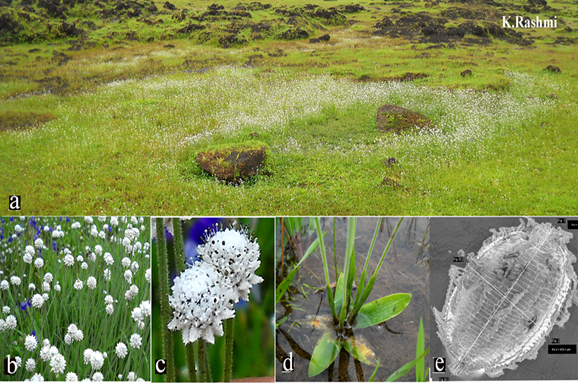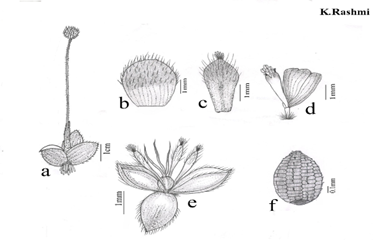Eriocaulon lanceolatum var. bhatkalense var. Nov. (Eriocaulaceae)- A New Variety From The Western Ghats, India
Article Information
K. Rashmi*, G. Krishnakumar
Department of Applied Botany, Mangalore University, Mangalagangothri, 574 199, India
*Corresponding Author: K. Rashmi, Department of Applied Botany, Mangalore University, Mangalagangothri, 574 199, India
Received: 04 May 2020; Accepted: 29 May 2020; Published: 22 July 2020
Citation: K. Rashmi, G. Krishnakumar. Eriocaulon lanceolatum var. bhatkalense var. Nov. (Eriocaulaceae)- A New Variety From The Western Ghats, India. International Journal of Plant, Animal and Environmental Sciences 10 (2020): 135-139.
View / Download Pdf Share at FacebookAbstract
Abstract
A new variety of Eriocaulon is described and illustrated from the low altitude monsoon vegetation of the Western Ghat region of Karnataka, India. This vareity is distinct in the obovate leaves, 2 or 3 male flower sepals, presence of glands at the tip of petals.
Keywords
Eriocaulon; Western Ghats; Variety; Bhatkal plateau
Eriocaulon articles, Western Ghats articles, Variety articles, Bhatkal plateau articles
Article Details
Introduction
The genus Eriocaulon L. (Eriocaulaceae), with about 400 species (Mabberley, 2008), is distributed in tropical and subtropical regions of the world. Ansari & Balakrishnan (2009) have reported 85 species and -varieties of Eriocaulon in India. Since then, 12 more species have been described from peninsular India (Manudev et al., 2015). Our floristic studies on the monsoon flora of the low altitude coastal lateritic plateau in the Bhatkalplateau, Uttara Kannada district, Karnataka state, India, resulted in the collection of an Eriocaulon species. Review of literature and comparison with the herbarium catalogue (Kew, world check list) indicate that this is new variety of the E.lanceolatum.
Eriocaulon lanceolatum var. bhatkalense var. nov. K.Rashmi and G.Krishnakumar sp.nov. (Figure: 1, 2) Eriocaulon lanceolatum Miq. ex Körn. Eriocaulon kasaragodense R.Ansari, V.J.Nair & N.C.Nair. Eriocaulon lanceolatum Miq. ex Körn. ssp. pilosum Moldenke.
Type: India, Karnataka, Uttara Kannada District, Bhatkala, Bhatkal is located at 13.97°N 74.57°E., 3m A.S.L., 12 Sept 2016, K.Rashmi and G.Krishnakumar, 1450 (holotype: CAL, isotypes: MH, Herbarium, Department of Applied Botany, Mangalore University).
Description
Annual herbs, up to 20cm height, root stock absent. Leaves 2-3.5×0.5-1.8cm, 20-26 nerved, smaller than sheaths, rosulate, obovate or lanceolate, acute at apex, 18-20 nerved, glabrous on both surface, margin hairy. Peduncle 1-7, up to 15cm long, pubescent, very soft, 4-angled. Spathe up to 5cm, 7-8- nerved, hairy with lanceolate limb, limb 5.2mm long, acute at apex, entire. Capitula hemispherical, slightly lax. Ca 5mm across, white. Receptacle conical, sparsely setose. Involucral bract 1.2×2.0mm, spreading, crenate at apex, obovate to orbicular, concave, hairy towards apex, hairs thin, hyaline. Floral bract 1.2×1.2mm, slightly keeled, cuneate, grey, densely hairy, towards apex, hairs thick, shiny, white. Staminate flowers up to 4mm long; pedicels Ca 0.4mm, hairy at base; Sepals 3, connate into a spathe of Ca 1.5×3.2mm, concave, 3-lobed, lobes broad, glabrous, grey. Anthophore ca 0.8mm long; Petals 3, minute, each with a black gland at the tip, hairy at the top of glands, hairs thick, short, white. Staminodes 3, closely arranged at the base of petals. Anthers 6, black; filament up to 4mm long, triangular at base. Pistillate flowers with pedicels up to 0.5mm long, hairy; Sepals 2 or 3, equal, Ca 1.6×1.5mm long, free, oblanceolate, acute at apex, membranous, grey, hairy at the margin towards apex; corolla stiped, Ca 0.15mm long; Petals 3, each with a black gland at the tip, equal, hairy, hairs two types: thin, longer, hyaline hairs on the upper half of the petals and thick, shorter, white hairs at the top of glands. Ovary trilobed. Seeds ca 0.4×0.15mm, dark brown, obovate, slightly apiculate at apex, cells of seeds coat transversely elongated, aligned in vertical rows, projections from the center of transverse radial walls, some cells without projections, setiform, minutely dialated at apex, Figure: 1, 2.
Etymology: The specific epithet bhatkalense is after the type locality, the Bhatkal plateau in the Western coast of Karnataka state.
Habitat: Bhatkal plateau covers about 425 Hectares of area. It has richest laterite floristic diversity when compared to any other major plateaus of coastal region of Southern Western Ghats region. Eriocaulon lanceolatum var. bhatkalense is part of this herbaceous vegetation. It grows luxuriously assossiated with Eragrostis indica Link, Eriochloa acuminata (J.Presl) Kunth, Utricularia reticulata Sm. etc,.
Conservation Status: So far E. lanceolatum var. bhatkalense var. nov. has been collected from only Bhatkal plateau. Due to Acacia plantations, mud roadsand conversion to housing sites population of the speciesis considerably reduced. Also these large acres of land had been identified by the government in Uttara Kannada district for distribution among the poor. In southern coastal region of Western Ghats, this kind of laterite plateau with great floral diversity is seen only in Madayaipara plateau region of Kerala state. However, further field studies are required for a status assessment of this species. Hence, it is categorized as 'Data Deficient' (DD) under IUCN categories and criteria (IUCN 2014).
Additional Specimens Examined
India, Karnataka, Uttara Kannada District, Bhatkala. Rashmi K and Krishnakumar G 1503 dated 20 Sept. 2016 (in flower), Rashmi K and Krishnakumar G 1505 dated 20 Sept. 2016 (in fruit). Deposited in the Herbarium, Department of Applied Botany, Mangalore University, India.
Table 1: Comparison of Eriocaulon lanceolatum var. bhatkalense with Eriocaulon lanceolatum var. lanceolatum
|
Character |
Eriocaulon lanceolatum var. bhatkalense |
Eriocaulon lanceolatum var lanceolatum |
|
Leaves |
2×1.8 cm, hairy at margin |
9×1.5cm, hairy at margin, glabrous or sparsely pilose |
|
Involucral bract |
Hairy |
Hispid |
|
Male flower: Pedicel |
Hairy at base |
Glabrous |
|
Sepal |
Glabrous |
Glabrous or sparsely pubescent towards tip |
|
Petal |
Glands at the tip of petal |
Glands below the margin of the petal at apex |
|
Female flowers: Sepal |
2 or 3, Broad |
3, Narrow |
|
Petal |
Glands at the tip of petal |
Glands below the margin of the petal at apex |
|
Seed |
Dark brown, Appendages dialated at apex |
Purple, Appenages bifurcated at apex |
Eriocaulon lanceolatum is endemic to Western Ghats (Kerala, Karnataka, Maharashtra) (Ahmedullah and Nayar 1986, Ansari and Balakrishnan 1994, 2009; Cook 1996). In Kerala it is reported from Bekal. In Maharashtra it is reported from Pune, Khandala, Mumbai, Gaganbavda, Sindhudurg, (Lakshminarasimhan, 1996), Kolhapur (S. Punekar in litt. 24 January 2011). In Karnataka it occurs in South and North Canara (Anshi National park and Nigundi). The distribution of this species in Gujarat is doubtful (Cook, 1996).
Akcnowledgements:
We thank to Mr.VinayUllas, Gunagi for the assistance in field work.Literature Cited:
- Ansari R, Balakrishnan NP. The family Eriocaulaceae in India- Bishen Singh Mahendra Pal Singh (2009).
- Herbarium catalogue., The Plant check list, Kew. Royal botanical garden, London.
- IUCN Red list categories and criteria, ver.3.1.– iucn Species Survival Commission (2014).
- Mabberley D J. Mabberley’s Plant-Book: A Portable Dictionary of Plants, Their Classification and Uses, 3rd edition. Cambridge: Cambridge University Press (2008).
- Manudev KM, Robi AJ, Nampy S. Eriocaulon biappendiculatum, a new species of Eriocaulaceae from the southern Western Ghats, India. Edinburgh Journal of Botany 72 (2015): 219.



 Impact Factor: * 3.6
Impact Factor: * 3.6 CiteScore: 2.9
CiteScore: 2.9  Acceptance Rate: 11.01%
Acceptance Rate: 11.01%  Time to first decision: 10.4 days
Time to first decision: 10.4 days  Time from article received to acceptance: 2-3 weeks
Time from article received to acceptance: 2-3 weeks 